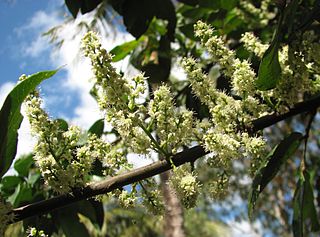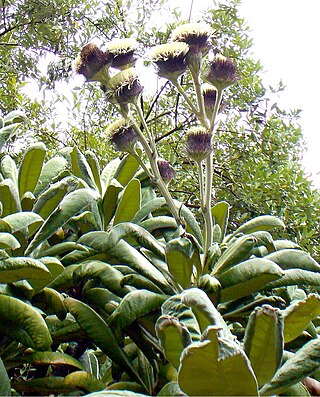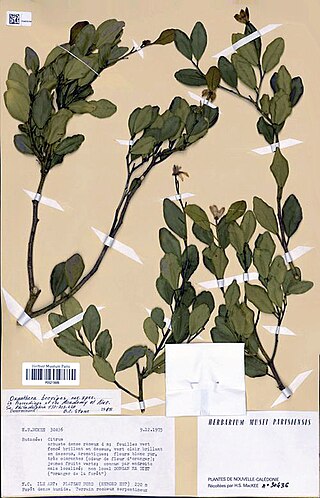
Trachypithecus is a genus of Old World monkeys containing species known as lutungs, langurs, or leaf monkeys. Their range is much of Southeast Asia.

Guioa is a genus of about 78 rainforest tree species known to science, which constitute part of the plant family Sapindaceae. They have a wide distribution, ranging from throughout Malesia, in Burma, Cambodia, Vietnam, Thailand, Malay Peninsula, Borneo, Sumatra, Philippines, Java, Flores, Timor, Sulawesi, Moluccas, New Guinea, further southwards through the east coast of Queensland and New South Wales, Australia and further eastwards to the Pacific Islands, including Tonga, New Caledonia, Fiji and Samoa.

Euryoryzomys emmonsae, also known as Emmons' rice rat or Emmons' oryzomys, is a rodent from the Amazon rainforest of Brazil in the genus Euryoryzomys of the family Cricetidae. Initially misidentified as E. macconnelli or E. nitidus, it was formally described in 1998. A rainforest species, it may be scansorial, climbing but also spending time on the ground. It lives only in a limited area south of the Amazon River in the state of Pará, a distribution that is apparently unique among the muroid rodents of the region.
This article is a list of biological species, subspecies, and evolutionary significant units that are known to have become extinct during the Holocene, the current geologic epoch, ordered by their known or approximate date of disappearance from oldest to most recent.
The Mount Pirri isthmus rat is a species of rodent in the family Cricetidae.

Oldenburgia grandis is a shrub or small, gnarled tree in the family Asteraceae. It occurs in the mountains around Grahamstown in South Africa. It grows to a height of about 5m on sandstone outcrops. It has thick corky bark and large leaves clustered at the ends of branches. The leaves are dark green and leathery, reminiscent of loquat leaves, but generally a good deal larger. The emergent leaves are densely and completely felted with white hair. Most of the felt is lost as the leaf matures, but some persists on under-surfaces. Flowers are white or purplish and borne in large heads some 5- to 12 cm in diameter. The flowerheads are terminal; The same plant may bear solitary heads, plus heads borne in loose, irregular panicles. It is threatened by habitat loss.

Carpoxylon macrospermum is a species of palm tree endemic to Vanuatu, and the only species in the genus Carpoxylon.

Jubaeopsis caffra, the Pondoland palm, is a flowering plant species in the palm family (Arecaceae). It belongs to the monotypic genus Jubaeopsis.
Anginon streyi is a species of flowering plant in the family Apiaceae. It is endemic to Namibia. Its natural habitat is subtropical or tropical dry shrubland.
Ficus ursina is a species of fig tree in the family Moraceae.

Helicia is a genus of 110 species of trees and shrubs, constituting part of the plant family Proteaceae. They grow naturally in rainforests throughout tropical South and Southeast Asia, including India, Sri Lanka, Indochina, Peninsular Malaysia to New Guinea and as far south as New South Wales.
Citrus oxanthera, synonym Oxanthera aurantium, is a species of plant in the family Rutaceae. Sometimes referred to commonly as the orange-flowered oxanthera, it is endemic to New Caledonia.
The false oranges are a group of flowering plants in the Citrus genus, within the family, Rutaceae. They are endemic to New Caledonia.

Oxanthera brevipes is a species of plant in the family Rutaceae. It is endemic to New Caledonia. It was proposed as a novel species by Benjamin C. Stone based on two specimens, distinguished from other false oranges by a non-articulated petiole. The genus Oxanthera has been synonymized with Citrus, but a name in Citrus does not appear to have been published, and Plants of the World Online regards "Oxanthera brevipes" as an unplaced name.
Citrus neocaledonica, synonym Oxanthera neocaledonica, the large leaf oxanthera, is a species of plant in the family Rutaceae. It is endemic to New Caledonia.

The World's 25 Most Endangered Primates is a list of highly endangered primate species selected and published by the International Union for Conservation of Nature (IUCN) Species Survival Commission (SSC) Primate Specialist Group (PSG), the International Primatological Society (IPS), Global Wildlife Conservation (GWC), and Bristol Zoological Society (BZS). The IUCN/SSC PSG worked with Conservation International (CI) to start the list in 2000, but in 2002, during the 19th Congress of the International Primatological Society, primatologists reviewed and debated the list, resulting in the 2002–2004 revision and the endorsement of the IPS. The publication was a joint project between the three conservation organizations until the 2012–2014 list when BZS was added as a publisher. The 2018–2020 list was the first time Conservation International was not among the publishers, replaced instead by GWC. The list has been revised every two years following the biannual Congress of the IPS. Starting with the 2004–2006 report, the title changed to "Primates in Peril: The World's 25 Most Endangered Primates". That same year, the list began to provide information about each species, including their conservation status and the threats they face in the wild. The species text is written in collaboration with experts from the field, with 60 people contributing to the 2006–2008 report and 85 people contributing to the 2008–2010 report. The 2004–2006 and 2006–2008 reports were published in the IUCN/SSC PSG journal Primate Conservation,, since then they have been published as independent publications.
Oxera baladica is a species of flowering plant in the family Lamiaceae. It comprises two subspecies, both of which are included as vulnerable species on the IUCN Red List:









